
Chapter 1
54% of businesses say they’re organizationally ready for XaaS today
Since our last survey, organizations admitting they’re not ready plunged from 13% in 2019 to just 2%.
The share of companies rating themselves “extremely ready” is up from 8% to 13% over the three years, as organizations complete their preparations.
What is the current status of your organization’s shift to an XaaS model (2019 vs. 2022)?

An analysis of the findings by sector yields further insights. The shift toward XaaS is being spearheaded by three sectors that we’ve termed the “core SaaS” grouping: software vendors, platform providers and digital services. In these sectors, the average proportion of “extremely ready” companies is 16%, while across the other sectors, it falls to 5%.
However, while the core SaaS sectors are leading the way in the move to as-a-service models, a number of other industries are already forming a second wave that will join the migration to XaaS in the coming years. These up-and-coming XaaS sectors are set to include industrial manufacturers, automotive, life sciences and health care, and tech and consumer products. Meanwhile, sectors that appear to be lagging in the move to XaaS include pure hardware vendors, industrial products and media providers. (Note: streaming is included under digital services).
XaaS is expected to make a rising contribution to revenues
As adoption rises, XaaS is expected to contribute an increasing share of overall revenues. Across industries, over 90% of our respondent companies are generating at least some of their revenues from as-a-service models today, rising to 100% in the next one to two years. Even more significantly, the proportion generating more than 80% of their revenues from XaaS is expected to surge from 3% now to 19% — almost one in five — in three to five years.
In terms of XaaS revenue share by sector, the core SaaS grouping is once again leading the way. But second-wave fast followers, such as life sciences and health care, are already generating more than 10% of their revenues from XaaS models.
What is the contribution of XaaS to your business revenues today, in one to two years, and in three to five years?

When asked to assess their own organizations’ and their industries’ maturity for enabling XaaS, respondents in the core SaaS sectors rate their own maturity well ahead of the rest at both a company and sector level. The most significant responses are from hardware vendors, who rate the XaaS maturity of their industry as being much higher than that of their own organizations — suggesting they feel they’re lagging behind their sector peers.
Competition and market trends remain major drivers of the switch to XaaS
Turning to the drivers behind organizations’ move to XaaS, the top two factors — general market trends and the changing competitive landscape — have remained unchanged since 2019. But lower down the list, there’s been significant change, with internal factors, such as revenue models and internal organizational strategies, climbing the ranking as XaaS becomes more central to business strategy.
Over half — 56% — of companies in the core SaaS cite additional revenue stream as their top driver for XaaS transformation, ahead of general market trends and the changing competitive landscape. For businesses outside that grouping, customer feedback is the number one driver.
What are the main drivers of your transformation to XaaS models?
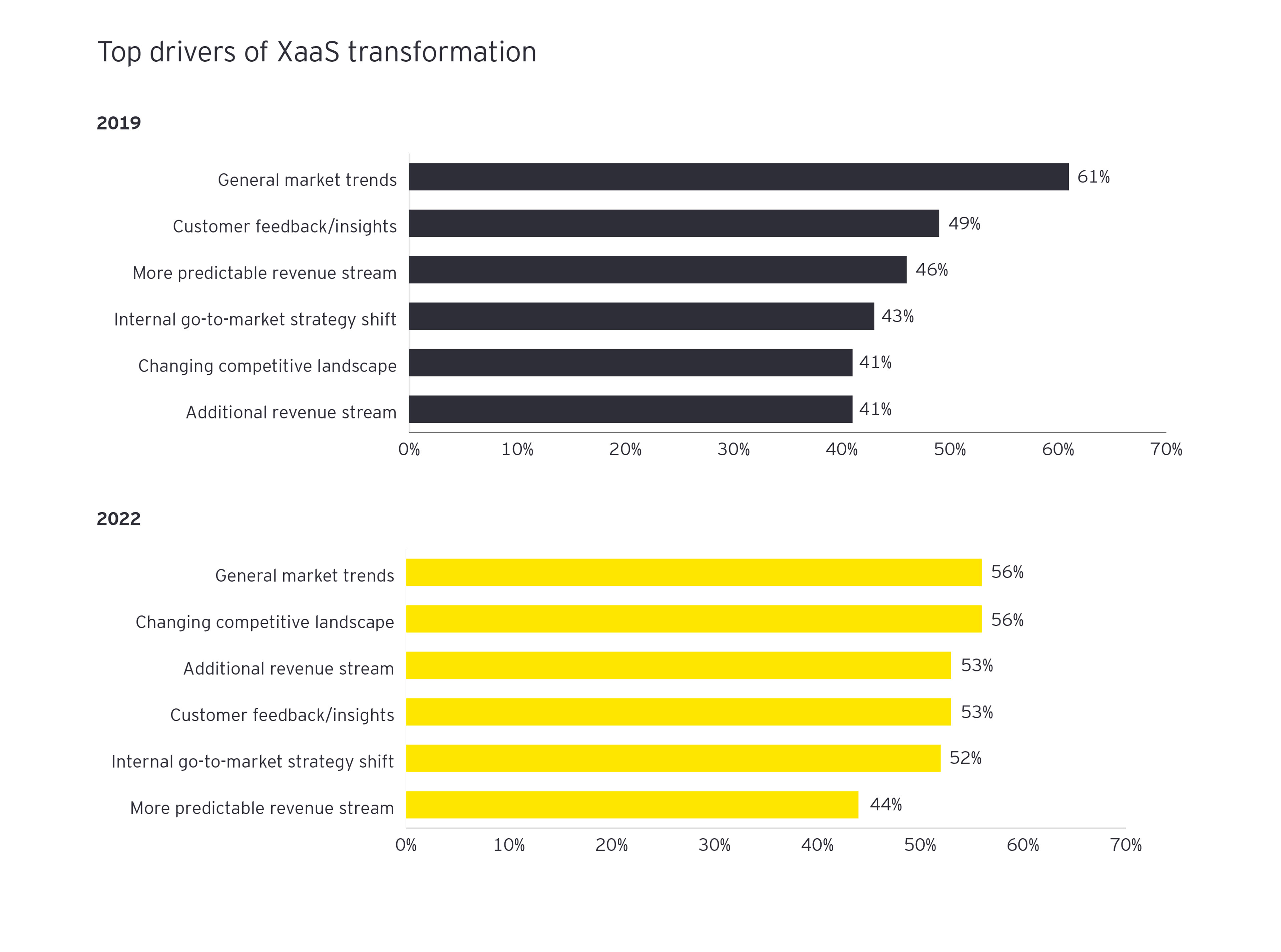
In our 2019 research, the leading challenges to XaaS transformation were communicating the XaaS value proposition and defining solutions. Today, the biggest hurdles have changed significantly, with organizations now facing two main sets of challenges.
The first revolves around the product strategy for XaaS offerings, such as developing product enhancements for XaaS, understanding what customers want, and defining XaaS monetization and pricing. The second is taking XaaS offerings to market, including defining the route to market, training and incentivizing sales teams, and marketing XaaS offers to different segments. Asked to cite their main areas of concern in transitioning to XaaS, organizations point to three main issues: data breaches and security, regulatory compliance and the risk of outages.
What are the biggest challenges to your transformation to XaaS models?
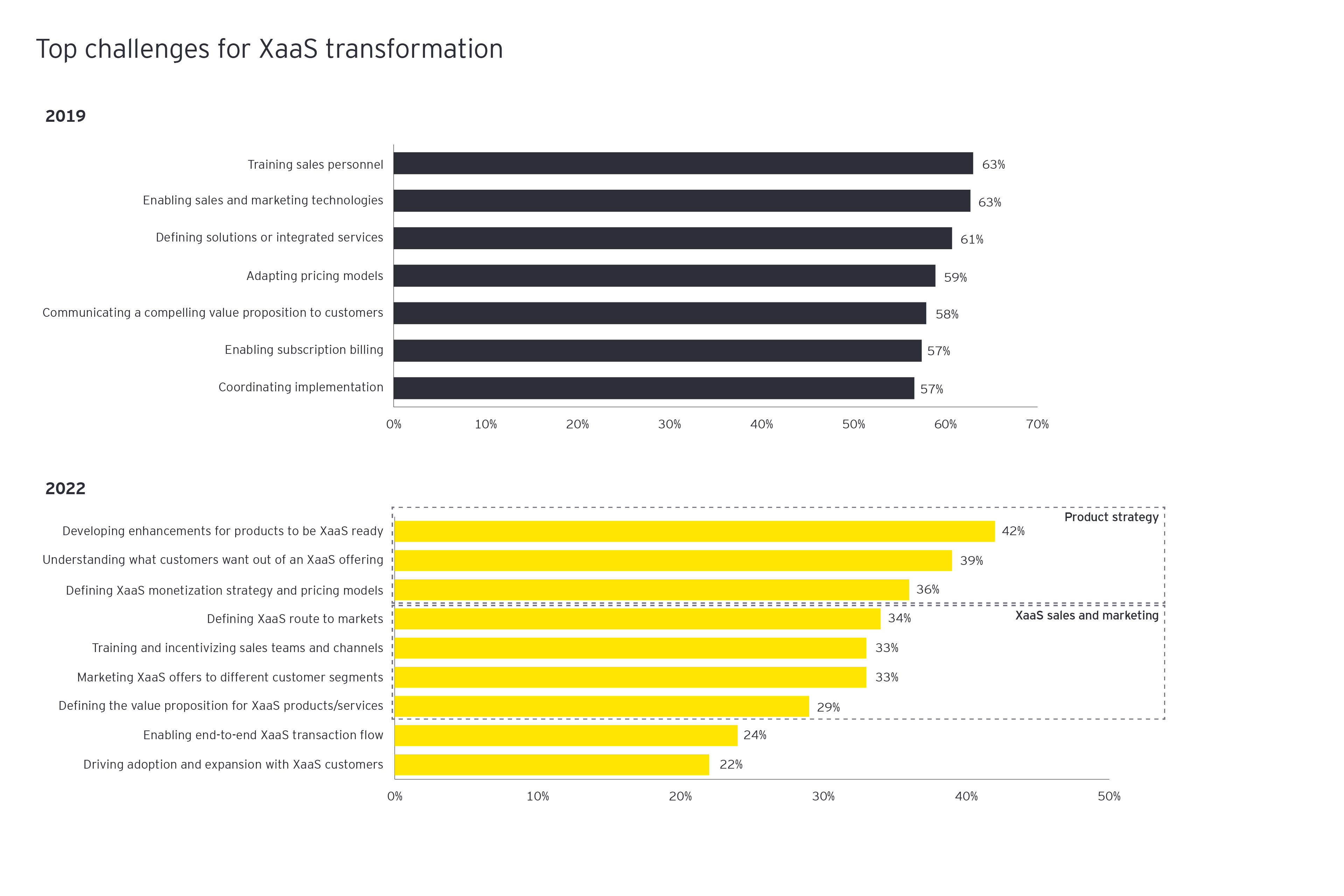

Chapter 2
XaaS may generate major revenue and customer experience upside
The substantial financial benefit from transitioning to XaaS was underlined during the global pandemic, when XaaS usage surged.
By the end of the second quarter of 2020, just a few months into the pandemic, XaaS revenues were significantly outperforming product revenues on a broad basis.
In light of such experiences, two-thirds — 67% — of all respondents to our study believe the overall financial upside presented by XaaS for their organizations over the next three years will generate millions of dollars, with 21% expecting more than US$1 billion. Hardware vendors, media providers and software vendors are expecting the biggest financial upside as a result of transformation to as a service.
What financial uplift do you anticipate from XaaS over the next three years?

This optimism over the financial impact of XaaS is bolstered by the Technology & Services Industry Association’s (TSIA) index of 50 technology companies, the Technology and Services 50 (T&S 50). On average, software T&S companies have seen product revenues decline by more than 12%, while service revenues, including SaaS revenues, have increased by more than 10%. Meanwhile, companies in the TSIA Managed Services Benchmarking database report an average growth rate of 32% for their managed services business, far outpacing the growth for products.
A further anticipated outcome of the migration to XaaS is improved customer engagement: 70% of organizations expect their XaaS route-to-market strategy to have a moderately or significantly positive impact on their direct engagement with end customers. For example, Xerox evolved from technology invention to service innovation by leading the managed services space.
Xerox – Evolution from technology invention to service innovation
Established as a pioneer in printing technology, Xerox transformed its business model to emerge as the leader in the managed printing services space. The company has steadily shifted from office printing products (business shrinking to almost half in the last 15 years), with managed services now accounting for almost 50% of its revenues. The transformation story of Xerox emphasizes how the shift to as-a-service models helped the business stay relevant with evolving market dynamics.
How do you expect XaaS to impact your company valuation, and does your capital allocation and M&A strategy reflect this opportunity?
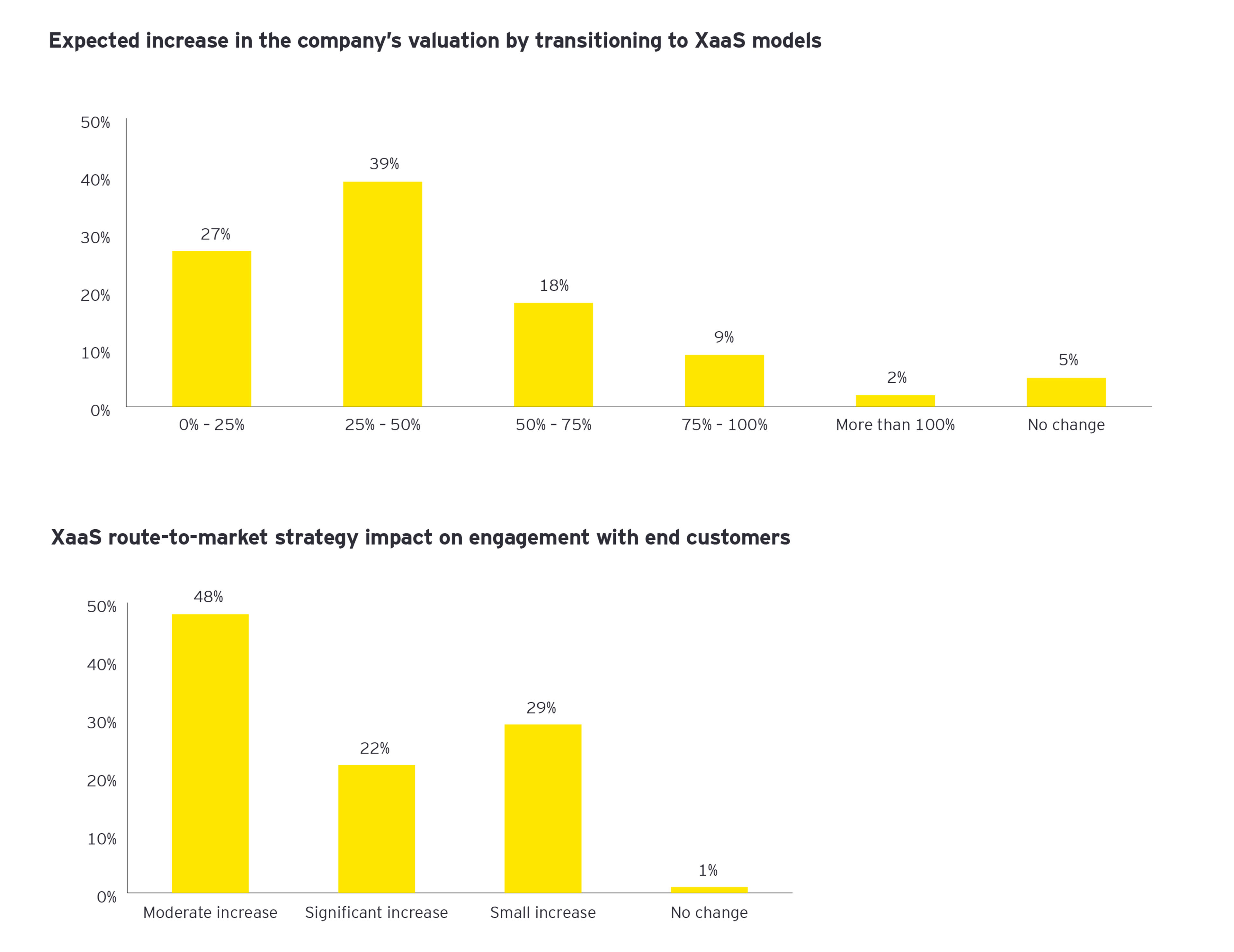
XaaS models are being adopted and leveraged across industries
A growing number of organizations across industries are announcing plans to shift the majority of their portfolios to XaaS offerings over the next few years, leveraging XaaS to add software and AI capabilities to create smart-connected products and services, expand markets, and develop new ways to monetize data and algorithms. The vast majority of adopters report that XaaS has helped them create new value propositions, business models, and products and services — and has even changed how they interact with their customers.
Lenovo and Rolls-Royce are two examples from very different sectors. PC and laptop vendor Lenovo launched its TruScale Infrastructure Services, a subscription-based infrastructure-as-a-service (IaaS) offering, in 2019; brought it under a single umbrella with Device-as-a-Service options in April 2021; and, more recently, broadened the offering into an XaaS platform to its entire portfolio in September 2021. And UK-based aero engine maker Rolls-Royce’s TotalCare® program offers customers long-term jet engine rental contracts charged on a fixed rate per flying hour, resulting in reduced waste, higher efficiency and a more robust supply chain.

Chapter 3
60% of organizations use subscription-based pricing models
While subscription is the prevalent pricing model, businesses are switching to consumption and outcome-based models for the future.
Around 60% of the organizations in our survey are currently using subscription models to charge for their XaaS offerings, while 50% are applying usage- or consumption-based models and 27% are using outcome-based charging. Among the core SaaS sectors, the proportion using subscription-based models is 73%, followed by 54% with usage or consumption models, and 29% with outcome-based models.
However, this situation is set to change dramatically. In the next three years, usage- and consumption-based models are projected to experience strong uptake, driven by evolving customer expectations. Asked about their plans for the next three years, just over 61% of companies are planning to implement usage- or consumption-based models, and 30% outcome-based models.
Health care and life sciences companies are expected to exhibit the highest adoption of outcome-based models. But there are challenges to be overcome in implementing these models, with companies citing four in particular: defining and quantifying the outcome, establishing a robust governance structure (including defining and measuring KPIs), addressing financial accounting and forecasting, and enhancing control of people and processes.
What XaaS model does your company offer today — and what do you plan to add in the next three years?
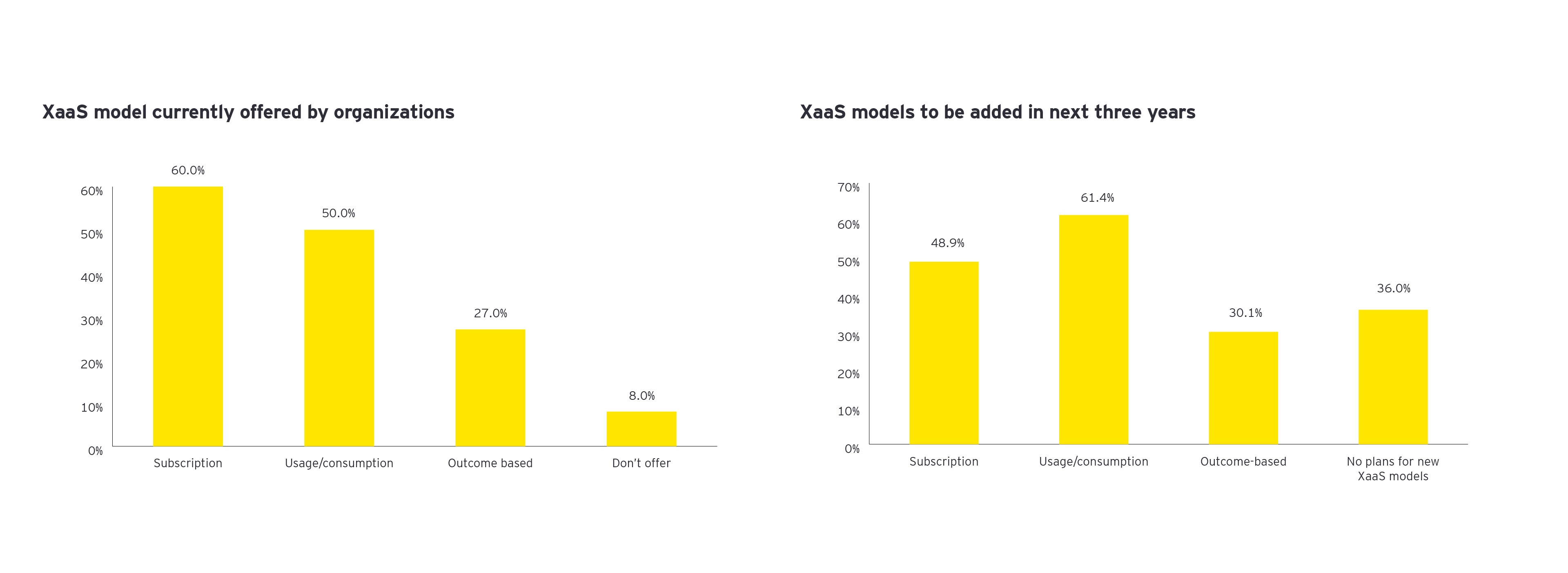
Looking across all organizations surveyed, 52% intend to shift from subscription to consumption models, with the main driver being a more predictable revenue stream. The proportion planning to make this switch rises to 56% among core SaaS companies, which cite the main drivers as evolving customer expectations and the changing competitive landscape. The shift to consumption models is highest for software vendors and media providers, at around 60%.
Why is your company shifting or planning to shift from subscriptions to consumption-based models?


Chapter 4
Companies are seeking to better align with modern buying behavior
Creating hybrid pricing models and combining subscription services with usage-based pricing offers better value and service to customers.
As companies shift from traditional subscription pricing toward usage-based models, they are seeking to better align with modern buying behavior and the value delivered by their products.
By combining their subscription services with usage-based pricing, companies can enable their customers to increase or enhance their offerings as needed. New customers may enter through a predictable subscription model and continue to access advanced features as needed through usage-based models. Firms are shifting toward usage-based pricing because it offers agility, affordability and minimal commitment, in turn translating into higher profitability.
The pivot to usage-based pricing has been made by startups such as Cypress, which introduced consumption-based pricing in March 2021; pre-IPO companies such as Kong, which announced a pay-as-you-go pricing tier in May 2021; and even long-established players such as 40-year-old Autodesk, which introduced pay-as-you-go pricing in September 2021.
What pricing models is your company offering or planning to offer for XaaS?
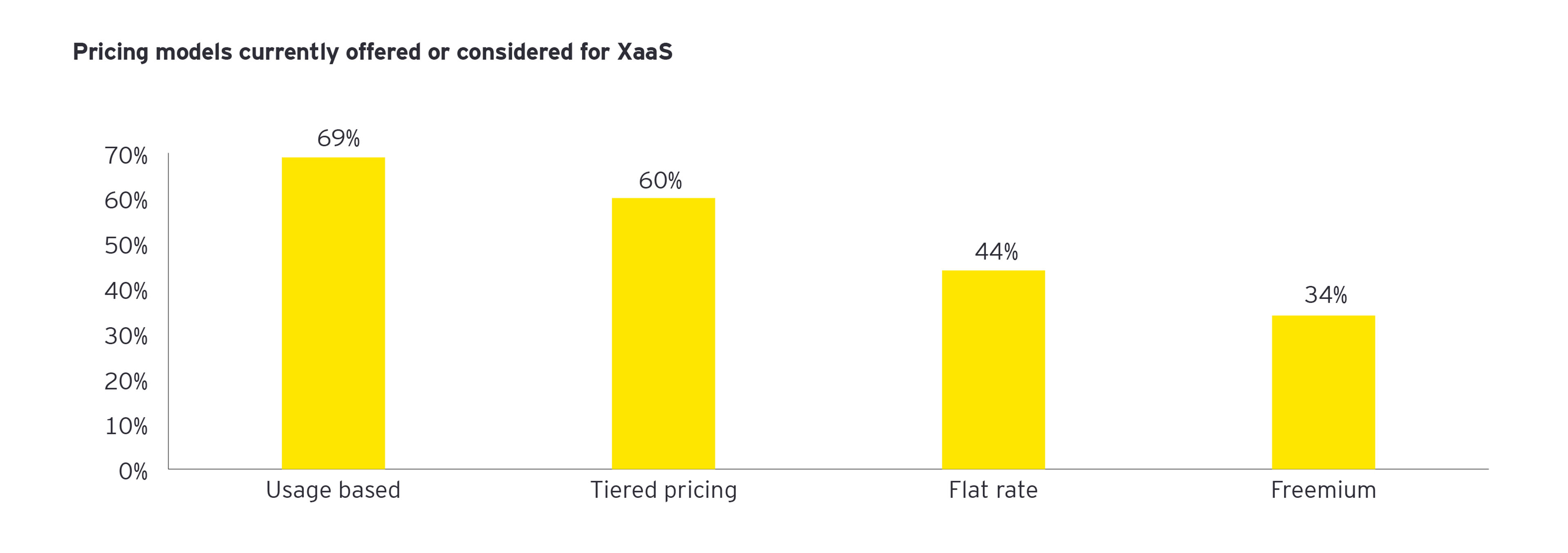
Key study findings include:
- 137% – Average net dollar retention for companies that implement usage-based pricing
- 2x – Growth in adoption rate for usage-based pricing, from 27% in 2018 to a projected 56% in 2022

Chapter 5
9% of all businesses have fully shifted to XaaS business models
While only 9% have completed XaaS transformations, 85% are at the progress stage, either piloting or operating at scale.
About 85% of the organizations in our research are in progress with their XaaS transformations, while just under one in ten have completed the journey. Among core SaaS companies, the proportion that has completed the transformation rises to 14%, while about 80% are at the progress stage. Outside this grouping, just 5% have completed their XaaS transformations.
What’s the current stage of your organization’s XaaS transformation?

However, an analysis by sector underlines the “second wave” of migration to XaaS that’s building up across industries beyond core SaaS. The sectors in this upcoming wave include life sciences and health care, and automotive manufacturers, which both rank in the top five sectors where companies have completed their XaaS transformations.
What business processes require significant or large transformation to enable the transition to XaaS?
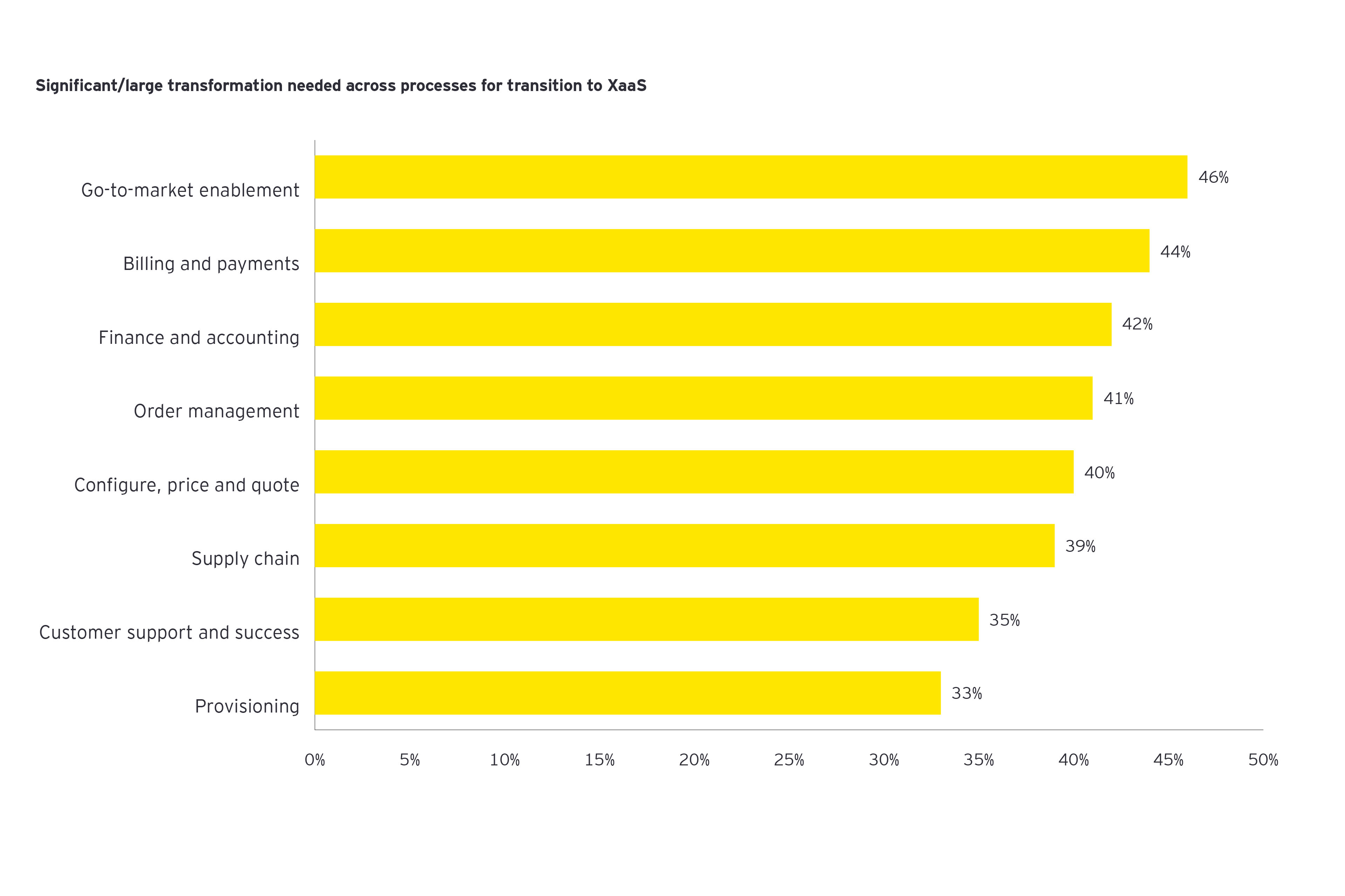
Sales and marketing and finance processes are the leading candidates for XaaS transformation
Turning to the processes that require transformation to operate XaaS models, our study shows that go-to-market enablement, billing and payments, and finance and accounting are the top three processes that need significant or large transformation. Similarly, the top processes requiring transformation in the core SaaS companies include billing and payments, go-to-market enablement and order management. What’s consistently clear is that sales and marketing — a key part of any business model — needs significant transformation for XaaS. These commercial changes include new channels and routes to market, greater direct digital marketing, new selling skills and commission structures, and in-product, telemetry-based upselling and cross-selling.
What’s the magnitude of change required in sales and partner capabilities to drive XaaS market success?

Further actions being taken to prepare for XaaS include setting up customer success functions to drive adoption and expansion of as-a-service models, a step undertaken by 86% of organizations, while more than one-third — 35% — have set up a new legal entity or tax structures for XaaS. A deeper analysis shows that route-to-market strategies are shifting toward online or direct-to-consumer sales, including among the core SaaS companies. And around 70% of our respondents are leveraging existing enterprise technology to support the transformation. Some of the significant statistics include:
- 86% of the organizations have a customer success function to drive adoption and expansion of as-a-service models with their customers.
- 70% of the organizations are leveraging existing enterprise technology to a moderate to large extent to support XaaS.
- 35% of the organizations have set up a new legal entity or tax structures for XaaS.
Jeff Johnson, Mike Kelly, Adi Mengi, Al Paul and Divya Sinha also contributed to this article.
Summary
The XaaS market is maturing, with more than half of companies reporting they are organizationally ready for as-a-service models. However, the market is moving quickly from basic subscriptions to consumption-based models and outcomes pricing. This is creating new challenges in designing integrated product strategies, with software, data, physical products and services being combined into solutions. XaaS investments are justified to generate new revenue streams, develop closer relationships with customers and better understand their needs, resulting in increased market valuations for enterprises across all sectors.


